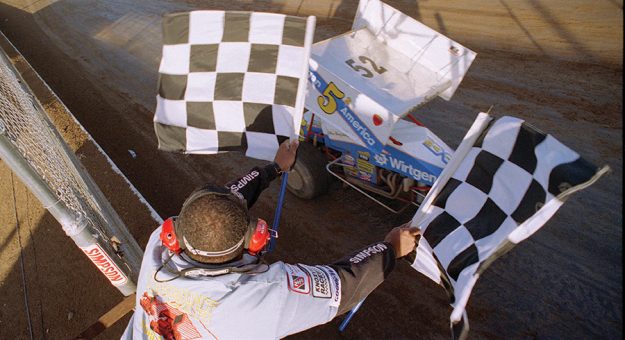The first hurdle was cleared when Hall took his call. Patterson laid out the basic parameters and predictably this all seemed like a pipedream to a typically skeptical executive. If there was good news it was that Patterson‘s idea was not summarily rejected out of hand.
To get the project on a firm fiscal foundation, Patterson targeted five primary sponsors and two took the bait. Barney Li who headed a car
care company named Eagle One was intrigued by Patterson‘s vision. When it was decided to add midget racing to the mix, Li‘s firm became the title sponsor for what became the Eagle One Midget Challenge.
The other key player was Bill Beichner, vice president of Slick 50, a lubricant company based in Houston. With Beichner‘s support in place the Slick 50 Sprint Car World Series was born.

Patterson reasoned with the two sponsors in the bag that the television side of the ledger was covered. He had his own 18-wheeler and his own satellite truck, although he was making healthy payments on both.
What he did have was a dedicated staff and three decades later he says, “Pat Patterson gets a lot of credit for thinking let‘s go do this and being the guy who had to ultimately hold the bag if things went wrong. But I can say this right now, if it wasn‘t for my staff this never gets done.”
Patterson had a relationship with sprint car driver Jeff Swindell who proved to be a key resource when it came time to swap ideas and perspectives. One of the key concerns was how to get World of Outlaw kingpin Ted Johnson on board.
Swindell got Patterson‘s attention when he casually remarked that these events would not require an official sanction. In the end, Johnson was free to sell merchandise at the events, a lucrative business even at that point in history. Patterson had been deeply involved in the sport for well over two decades but had never worn the promoter‘s hat. The first thing he needed was a race track to host his fledgling series.
The host track needed to have warm weather and low chance of rain. At Stephens suggestion, Patterson reached out to Manzanita Speedway promoter
Keith Hall.
 “Greg warned me that this guy was not going to be easy to deal with and was not necessarily the most beloved guy in motorsports,” Patterson explained. “I went to see Keith and his son Ladd. Now, I wasn‘t born yesterday. I had dealt with promoters before and had my eyes open.
“Greg warned me that this guy was not going to be easy to deal with and was not necessarily the most beloved guy in motorsports,” Patterson explained. “I went to see Keith and his son Ladd. Now, I wasn‘t born yesterday. I had dealt with promoters before and had my eyes open.
“So I went in and said, ‘Look guys here‘s the deal, we‘re trying to come out here and do some sprint car races in the wintertime and I want to lease your race track.‘ Their reaction was, ‘No, we aren‘t going to do that, but we might be willing to talk to you about doing some televised races.‘
“Well, I kind of needed to control both ends of this thing, on the fans side and the back gate in order to make things work,” Patterson continued. “I have really forgotten what our deal was, but it was one of those things where we agreed that I‘m going to keep an eye on you and you‘re going to keep an eye on me.”
Patterson soon discovered Dennis Wood was an important player in the Valley of the Sun. Wood had been at the helm at Phoenix Raceway and was the driving force behind the creation of the popular Copper World Classic. To use a contemporary term, he was an influencer.
“Dennis was like one of the unofficial Indianapolis mafia,” Patterson said. “When it came to racing he was also kind of like the kiss the ring guy in Phoenix. I had to get him to buy into this idea and he ended up being an incredible asset. He could decipher whatever Keith Hall was trying to do on my behalf. He was invaluable in that first year.”
With his ducks in a row, Patterson went back to TNN.
“I was hoping that TNN was going to kick some money in,” Patterson said. “Then 90 days before we were going to have a race I got a call from David Hall, who was not my best friend. He said, ‘Here‘s the deal. I will give you the time for this, but we aren‘t getting financially involved at all. Frankly we think you‘re a little out there. The bottom line is you can go out there and bring us the programming just like you do with that RaceDay show. The risk is all yours.‘”
Patterson pulled the trigger.
Among the staffing decisions he still faced was who to sign on as talent for the broadcasts.
“I had figured out how many staff people we needed out of Charlotte, but we had to go out and see what kind of television group we needed,” Patterson said. “I was not a good booth guy. I was a good read the teleprompter guy. I knew a lot about motorsports, but I felt if you are going to make this work you better get some talent who has some credibility. So my first phone call went to Mike Joy.
